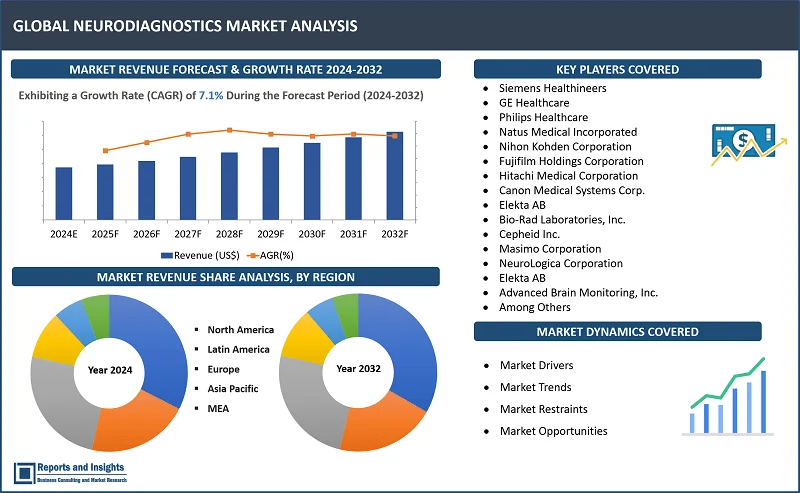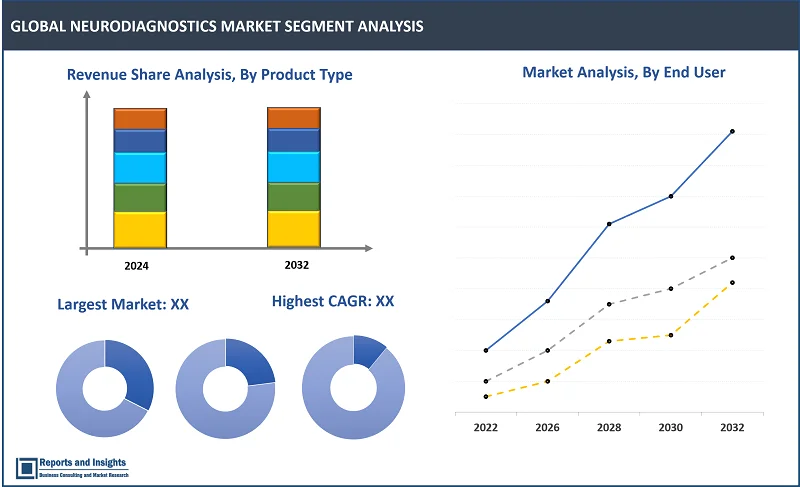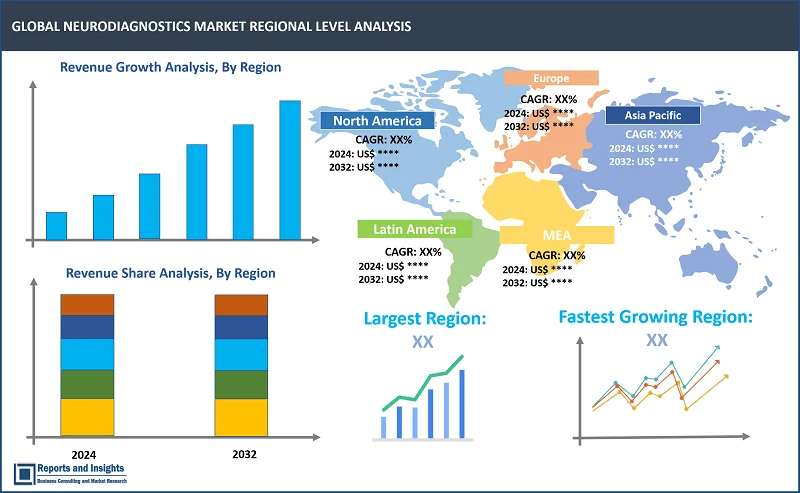Market Overview:
"The neurodiagnostics market was valued at US$ 8.3 Billion in 2023 and is expected to register a CAGR of 7.1% over the forecast period and reach US$ 15.4 Bn in 2032."
|
Report Attributes |
Details |
|
Base Year |
2023 |
|
Forecast Years |
2024-2032 |
|
Historical Years |
2021-2023 |
|
Market Growth Rate (2024-2032) |
7.1% |
Neurodiagnostics is the study and recording of electrical activity in the brain, central nervous system, and peripheral nervous system, and these recordings are used to gain crucial information, which can be used to assist in diagnosis and treatment of people with neurological problems, such as epilepsy, headaches, and head and spinal injuries, as well as seizures, sleep disorders, stroke, and coma.
Neurodiagnostic products, crucial in the diagnosis and monitoring of neurological disorders, include electroencephalograms, magnetoencephalograms, and neuroimaging through MRI and CT scans. These products are developed with highly advanced electronic components, sensors, and medical-grade materials to assure precision and safety in regard to patients. The process of manufacturing is characterized by design, assembly, calibration, and rigorous testing to ensure conformance to the strictest regulatory standards. Key raw materials include silicon for use in semiconductors, biocompatible polymers, and special alloys for sensor technologies. Neurodiagnostics are important since they basically track real-time information on brain function and contribute to the detection and management of conditions such as epilepsy, multiple sclerosis, and brain tumors, among others. These products find extended usage in hospitals, clinics, and research institutions, enabling various diagnostic and therapeutic applications.
The application techniques involve non-invasive procedures, with EEGs monitoring electrical activity in the brain and neuroimaging showing detailed anatomical and functional information. The recent development of portable and wireless EEG devices advances patient mobility and comfort. In addition, several AI and Machine Learning (ML) innovations improve the accuracy of diagnosis and predictive capabilities. Other new applications include personalized medicine with neurodiagnostics, where data-driven approaches tailor treatments to individual patient profiles. Neuroimaging is improving the understanding of neurodegenerative diseases, possibly leading to breakthroughs in their treatment. The global neurodiagnostic market is registering rapid growth as the global population ages, and increasing number of cases of neurological disorders occur continue to drive need for newer technological innovations and systems and solutions.

Neurodiagnostics Market Trends and Drivers:
Rapid growth of the neurodiagnostics market is driven by a number of key factors and global trends. These include increasing prevalence of neurological disorders, aging population, technological advancements in medical field, rising healthcare expenditure, and growing awareness and adoption of early diagnostic practices. The number of individuals being diagnosed with conditions such as Alzheimer's, epilepsy and Parkinson's Disease has also been increasing as the elderly population expands and age-related diseases and conditions incline. This is necessitating need for more advanced diagnostic tools, innovation in existing techniques and approaches, and integration of more advanced technologies and solutions.
Technological advancements are expected to continue to play a crucial role in market growth, with Artificial Intelligence (AI) enhancing imaging technologies and systems, bringing innovation in EEG devices, and non-invasive techniques, which is revolutionizing the field. Integration of AI in neurodiagnostics is enhancing accuracy and efficiency of diagnostic processes and making it possible for earlier and more precise and accurate detection and diagnosis of neurological conditions.
Some positive trends include increasing adoption of telehealth and remote monitoring technologies which is making neurodiagnostic tools more accessible to a wider population. Also, product strategies focusing on user-friendly, cost-effective, and highly accurate diagnostic devices are gaining traction, catering to both clinical and home-based healthcare settings. In addition, rising healthcare expenditure, modernization of existing healthcare infrastructure, facilities, and services are factors supporting steady adoption of advanced neurodiagnostic technologies. Government initiatives and increasing funding for neurological research are also contributing to major developments in the market.
Neurodiagnostics Market Restraining Factors:
A major factor having negative impact on potential growth of the market is high costs associated with advanced neurodiagnostic equipment and procedures, and this limits accessibility for patients and healthcare providers, particularly in low- and middle-income countries. This factor is further fortified by insufficient or inadequate reimbursement policies, which can deter the adoption of such cost-intensive technologies. Conducting Research and Development (R&D) also faces major challenges, as developing neurodiagnostic tools requires substantial investment in time, expertise, and resources. Also, regulatory approvals are stringent, and the process of bringing a new product to market is both costly and time-consuming, potentially slowing innovation and market entry for new technologies.
In addition, disadvantages or potential health risks, such as repeated exposure to certain neuroimaging techniques, such as radiation dose from CT scans, which can cause some long-term risks to patients. Also, potential discomfort or inconvenience associated with some procedures such as EEG monitoring can reduce patient compliance and preference for such diagnostics and procedures. Moreover, availability of substitute, traditional, and alternative methods such as clinical examinations and basis neurological assessments can have a certain level of impact on preference for more advanced and modern techniques and procedures, and this could be defined by factors like high costs, ease of use of alternatives, and these older approaches sufficing in significantly large number of instances to achieve favorable patient outcomes.
Neurodiagnostics Market Opportunities:
The global neurodiagnostics market presents a number of high-potential opportunities for leading players to capitalize on and expand their operations. Innovating new products through integration of advanced technologies such as Artificial Intelligence (AI) and Machine Learning (ML) can significantly enhance diagnostic accuracy and efficiency. For instance, AI-driven software that can quickly analyze neuroimaging results and detect abnormalities with high precision offers convenience, rapid diagnosis, and create a lucrative revenue stream.
Also, expanding into emerging economies can enable companies to capitalize on the trend of modernization of healthcare infrastructure and adoption of advanced diagnostic tools and solutions in such countries. Establishing local partnerships, investing in regional distribution networks, and developing and offering tailored products to cater to specific needs and price points can create further revenue opportunities in these markets. In addition, entering into strategic mergers and acquisitions can enable diversification of product portfolio and open avenues to new technologies and markets. For instance, acquiring a firm specializing in innovative neurodiagnostic tools or complementary healthcare technologies can enhance position and revenue potential.
Furthermore, engaging in long-term agreements and partnerships with healthcare institutions and research centers and organizations can open further avenues for revenue growth through development of cutting-edge diagnostics tools and service agreements to ensure provision of equipment and services.
Neurodiagnostics Market Segmentation:

By Product Type
- Diagnostic Imaging Systems
- Electroencephalogram (EEG) Systems
- Magnetoencephalogram (MEG) Systems
- Near-Infrared Spectroscopy (NIRS) Systems
Among the product type segments, the diagnostic imaging systems segment is expected to account for the largest revenue share. This is supported by widespread use in accurately diagnosing a variety of neurological conditions such as tumors, strokes, and neurodegenerative diseases. The advanced capabilities of MRI and CT scans in providing detailed brain images are driving adoption of these systems, and also, continuous technological advancements, such as AI integration, enhance imaging accuracy and efficiency are factors expected to continue to support revenue growth of this segment.
By Condition
- Epilepsy
- Alzheimer's Disease
- Parkinson's Disease
- Stroke
- Joint Health
- Other Indications
Among the condition segments, the epilepsy segment is expected to account for the largest revenue share, and this can be attributed to high prevalence of the condition globally and the critical need for accurate, ongoing monitoring and diagnosis. Neurodiagnostic tools such as EEGs are essential for detecting and managing epilepsy, and further advancements in neuroimaging and monitoring technologies, coupled with increased awareness and diagnosis rates, are key factors supporting robust revenue growth projected for this segment.
By End User
- Hospitals
- Diagnostic Laboratories
- Ambulatory Surgical Centers
- Research Institutes
Among the end user segments in the neurodiagnostics market, the hospitals segment is expected to account for the largest revenue share. This projection is supported by the high volume of patient inflow, advanced healthcare infrastructure, and the availability of skilled professionals in these settings. Hospitals are often the primary sites for comprehensive diagnostic and treatment services, including neurodiagnostics, due to capacity to integrate cutting-edge technologies and offer specialized care. Also, the rising prevalence of neurological disorders necessitates extensive diagnostic facilities, further supporting a rise in patient footfalls to hospitals.
By Application
- Clinical Diagnostics
- Research and Development
- Treatment Monitoring
- Personalized Medicine
Among the application segments, the clinical diagnostics segment is expected to account for the largest revenue share. This is primarily due to the essential role of neurodiagnostics in diagnosing various neurological disorders, such as epilepsy, Alzheimer's disease, and stroke. Increasing prevalence of these conditions, coupled with rising demand for early and accurate diagnosis are major factors driving inclining adoption of neurodiagnostic tools in clinical settings. Also, advancements in technology, such as AI-driven diagnostic algorithms, is expected to further enhance the efficiency and accuracy of clinical diagnostics, and this is likely to continue to support revenue growth of this segment.
By Region

North America
- United States
- Canada
Europe
- Germany
- United Kingdom
- France
- Italy
- Spain
- Russia
- Poland
- Benelux
- Nordic
- Rest of Europe
Asia Pacific
- China
- Japan
- India
- South Korea
- ASEAN
- Australia & New Zealand
- Rest of Asia Pacific
Latin America
- Brazil
- Mexico
- Argentina
Middle East & Africa
- Saudi Arabia
- South Africa
- United Arab Emirates
- Israel
- Rest of MEA
The global neurodiagnostics market is divided into five key regions: North America, Europe, Asia Pacific, Latin America, and the Middle East and Africa. North America leads among the regional markets in terms of revenue share in the global neurodiagnostics market, with the United States (US) accounting for majority revenue contribution among the countries in the region. This can be attributed to presence of advanced healthcare infrastructure and high healthcare expenditure. In Europe, countries such as Germany and the United Kingdom (UK) lead among the regional the markets in terms of revenue share contribution, driven by well-established healthcare systems and substantial investments in medical technology. In Asia Pacific, Japan and China are major revenue contributors due to rising healthcare expenditure and increasing prevalence of neurological disorders among a rapidly expanding elderly population. Some common factors driving revenue growth of these regional markets include technological advancements, increasing prevalence of neurological disorders, and rising awareness about early diagnosis and treatment options.
Leading Companies in Neurodiagnostics Market & Competitive Landscape:
The competitive landscape in the global neurodiagnostics market is characterized by intense rivalry among leading companies striving to maintain their positions and expand their consumer base. Key players such as Siemens Healthineers, GE Healthcare, Philips Healthcare, and Natus Medical Incorporated compete through various strategies. One common approach is product innovation, where companies invest heavily in research and development to introduce advanced neurodiagnostic technologies and solutions, enhancing diagnostic accuracy and patient outcomes.
In addition, strategic collaborations and partnerships with healthcare institutions and research organizations enable companies to broaden their market reach and access new customer segments. Moreover, expansion into emerging markets presents growth opportunities, prompting companies to establish local presence and distribution networks to cater to evolving healthcare needs. Overall, the competitive landscape is dynamic, with leading companies leveraging innovation, partnerships, and market expansion strategies to maintain their competitive edge and create revenue growth opportunities in the neurodiagnostics market.
These companies include:
- Siemens Healthineers
- GE Healthcare
- Philips Healthcare
- Natus Medical Incorporated
- Nihon Kohden Corporation
- Fujifilm Holdings Corporation
- Hitachi Medical Corporation
- Canon Medical Systems Corp. (Formerly Toshiba Medical Systems Corporation)
- Elekta AB
- Bio-Rad Laboratories, Inc.
- Cepheid Inc.
- Masimo Corporation
- NeuroLogica Corporation
- Elekta AB
- Advanced Brain Monitoring, Inc.
Recent Developments:
- February 2024: Threshold NeuroDiagnostics, which is a startup neural interface company, announced that the U.S. Patent and Trademark Office granted U.S. Patent No. 11904169 for the Medusa Electrode. This device bridges neuromodulation electrodes with neurodiagnostic equipment and AI algorithms, enhancing precision and accessibility in neural interface technology. The FDA-registered Class II (exempt) product transforms neuromodulation research by translating manufacturer-specific connections into universal EEG plugs, enabling cost-effective access to over 70,000 invasive electrodes annually in the U.S. It facilitates seamless integration between the nervous system and neurophysiology equipment, improving clinical applications and research.
- February 2024: Koneksa, which is an evidence-based digital biomarkers company, partnered with Beacon Biosignals, which is a leading computational neurodiagnostics firm, to launch a clinical trial aimed at integrating Beacon’s at-home EEG into Koneksa's Neuroscience Solution Toolkit. This collaboration utilizes Beacon's platform, which applies machine-learning algorithms to enhance insights into brain activity and offers comprehensive data analysis and visualization capabilities. The LEARNS study will assess the combined solution's effectiveness in neurological and sleep disorders, comparing at-home EEG with in-clinic polysomnography. Current areas include Parkinson’s disease, narcolepsy, obstructive sleep apnea, Alzheimer’s disease, Huntington’s disease, and mild cognitive impairment.
- January 2023: Natus Medical Incorporated (Natus), which is a prominent provider of medical device solutions specializing in the screening, diagnosis, and treatment of central nervous and sensory system disorders, announced completion of its acquisition of Micromed Holding SAS (Micromed), which is a global leader in neurophysiology solutions. The integration of Micromed products into the Natus Neuro portfolio marks a significant expansion of Natus' neurodiagnostic offerings. This addition strengthens Natus' position as a leader in neurodiagnostics, enhancing its portfolio across electroencephalography (EEG), polysomnography (PSG), electromyography (EMG), and Intensive Care Unit (ICU) monitoring. The synergy between these products and the collective organizational expertise will deliver added value to customers worldwide and provide a robust platform for future product innovations.
Neurodiagnostics Market Research Scope
|
Report Metric |
Report Details |
|
Neurodiagnostics Market size available for the years |
2021-2023 |
|
Base Year |
2023 |
|
Forecast Period |
2024-2032 |
|
Compound Annual Growth Rate (CAGR) |
7.1% |
|
Segment covered |
Product Type, Condition, End User, Application, and Region |
|
Regions Covered |
North America: The U.S. & Canada Latin America: Brazil, Mexico, Argentina, & Rest of Latin America Asia Pacific: China, India, Japan, Australia & New Zealand, ASEAN, & Rest of Asia Pacific Europe: Germany, The U.K., France, Spain, Italy, Russia, Poland, BENELUX, NORDIC, & Rest of Europe The Middle East & Africa: Saudi Arabia, United Arab Emirates, South Africa, Egypt, Israel, and Rest of MEA |
|
Fastest Growing Country in Europe |
The UK |
|
Largest Market |
North America |
|
Key Players |
Siemens Healthineers, GE Healthcare, Philips Healthcare, Natus Medical Incorporated, Nihon Kohden Corporation, Fujifilm Holdings Corporation, Hitachi Medical Corporation, Toshiba Medical Systems Corporation, Elekta AB, Bio-Rad Laboratories, Inc., Cepheid Inc., Masimo Corporation, NeuroLogica Corporation, Elekta AB, Advanced Brain Monitoring, Inc. |
Frequently Asked Question
What is the size of the global neurodiagnostics market in 2023?
The global neurodiagnostics market size reached US$ 8.3 Billion in 2023.
At what CAGR will the global neurodiagnostics market expand?
The global market is expected to register a 7.1% CAGR through 2024-2032.
Who is the leader in the neurodiagnostics market?
Siemens Healthineers and GE Healthcare are at the forefront due to extensive product portfolios, technological advancements, and global market presence.
What are some key factors driving revenue growth of the neurodiagnostics market?
Some factors driving market revenue growth include increasing prevalence of neurological disorders, technological advancements in diagnostic imaging and monitoring systems, and rising demand for early and accurate diagnosis.
What are some major challenges faced by companies in the neurodiagnostics market?
Companies in the neurodiagnostics market face challenges such as stringent regulatory requirements, high cost of advanced neurodiagnostic equipment, limited reimbursement policies, and competition from traditional diagnostic methods.
How is the competitive landscape in the neurodiagnostics market?
The competitive landscape in the neurodiagnostics market is characterized by intense rivalry among leading companies striving to maintain their positions and expand their consumer base.
How is the neurodiagnostics market report segmented?
The market report is segmented on the basis of Product Type, Condition, End User, Application, and Region
Who are the key players in the neurodiagnostics market report?
Key players in the market report include Siemens Healthineers, GE Healthcare, Philips Healthcare, Natus Medical Incorporated, Nihon Kohden Corporation, Fujifilm Holdings Corporation, Hitachi Medical Corporation, Toshiba Medical Systems Corporation (Formerly Toshiba Medical Systems Corporation), Elekta AB, Bio-Rad Laboratories, Inc., Cepheid Inc., Masimo Corporation, NeuroLogica Corporation, Elekta AB, Advanced Brain Monitoring, Inc.

